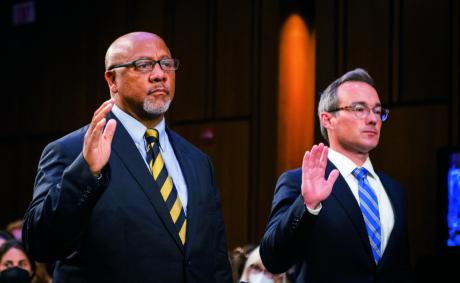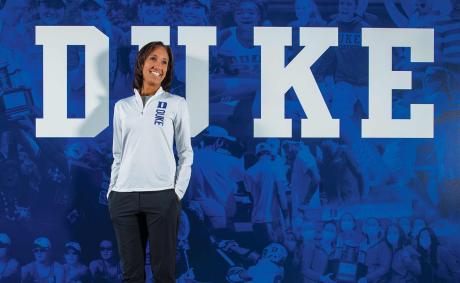Fewer opportunities to participate in extracurriculars that were shut down. Information lost in the static. Standardized tests optional. A year and a half of remote classes cratering a grade-point average. Or grade accommodation rendering GPA data useless. Family illness or even death demolishing a student’s ability to cope. A houseful of people all working and studying at home in too-few rooms, with too-few devices, trampling adolescent needs for concentration and privacy. National testing showed that younger schoolchildren lost two decades of progress; testing after the pandemic showed drops in scores not seen in 30 years.
But you know where COVID has not shown up? In applications to Duke.
“We don’t see much of it,” says dean of undergraduate admissions Cristoph Guttentag.
Wait, what?
“We haven’t seen much of a difference” in student records, he says, and it’s not just Duke. “I was at a conference of essentially private, highly selective colleges and universities. And this phenomenon was not a topic of conversation.”
It’s counterintuitive. How can COVID not be the overwhelming fact in applications over the last few years? Current high school seniors spent their sophomore year at home and their junior year recovering, and they’re looking at trying to make sense of their shattered high school years on college applications. Recent classes have had it as bad or worse.
And yet, look at Duke applications and you see the usual off-the-charts quality.
“One, there is a self-selection process, right?” Guttentag says. He describes a student he knew of who was second in his high school class. But with a couple B’s he didn’t apply to Duke. And he’s not even an extreme case.
“There are a lot of kids, I think, that are in the situation where things just have gone south for them,” Guttentag explains. “And they just go, ‘I’m not going to apply.’ That’s one thing.” A second thing is Duke adopting, as did many schools, a test-optional admissions policy. “All these kids started applying that in the past would not have applied. They would have selected themselves out because they would have said, ‘Oh, my SATs or ACTs aren’t high enough.’”
So, between kids whose grades or extracurriculars were COVID casualties self-selecting out and kids whose optional test scores no longer caused them to self-select out, Duke’s application pool looked as pristine as ever, and larger, too. “I was surprised last year, and I was surprised this year at how little difference there was in the applications,” Guttentag says. “It’s just the weird bubble that we’re in that we don’t see it.”
Nikki Baskin A.M.’19, associate director of undergraduate admissions, sees what Guttentag sees, and she adds another consideration: grade inflation. Many high schools, adapting to the complexity of their students’ school years, have encouraged a looseness in grading. “Some schools have it in writing,” she says, “like a kind of do-no-harm policy, and you know, erring on the side of grace and rounding up a little bit. Providing a little room.” But not all high schools do this, which introduces further complexity, as do the vagaries of class rank, which Guttentag sees as scattershot. “Like, 60 percent of the kids applying to Duke don’t have class rank,” making class rank something of a wild card.
“There used to be a Common Application essay prompt that talked about failure. And students were scared to respond to that one.”
-Nikki Baskin A.M.’19, associate director of undergraduate admissions
Yet at a time when every element of students’ records is complicated, Baskin encourages them to resist that self-selection. “We’re reading with context in mind,” she says. “We’re asking ourselves, when the student obviously went to school during the pandemic, what does this mean? How was the school impacted? Did the grading scale change, were certain classes no longer offered?” She recognizes the impossible position applicants are in, and she urges them to expect colleges to try to understand. “It’s not natural to sit in front of Zoom and take classes all day.” This has been an unprecedented time, and students should embrace that, Baskin says.
Like Guttentag, she fears that admissions officers see either self-selection or very careful editing. “‘I just want to show you the best of me’ – we’ve always seen that,” she says. “There used to be a Common Application essay prompt that talked about failure. And students were scared to respond to that one.” This may be a moment, she urges, for applicants to open up about their problems, not just present what they think a Duke applicant ought to look like. To be one in a million, that is, rather than simply one of a million. She notes that the Common Application has an extra section, titled Additional Information, where students can describe exactly how the pandemic affected them, from illness or death to loss of work or privacy to the toll taken on mental and emotional health. Not meant to be a second essay, the section gives students the opportunity to not use their main essay on the pandemic but to still explain their situation.
And nobody thinks the pandemic has a sunny side, but Guttentag mentions an acquaintance at a less-selective school who had been an admissions officer at Cal Tech. “He said, ‘Yeah, I’m really happy. One of the cool things is we can admit kids that we couldn’t admit at Cal Tech, who are cool kids.” That is, at many schools, the pandemic provides what may be a welcome shakeup to GPA and scores-focused admissions. “They can go, ‘Your presentation is not classically perfect, but you’ve got the chops.’”
Baskin has a timelier metaphor. The numbers on an application put in an appearance, but that’s only the start. “It’s like Zoom, right?” she says. “We see this, but we don’t know what’s going on, you know, behind us. It’s just a facade.” The pandemic has put us all on Zoom, but it’s also helped admissions officers get behind the appearance. “Students did crack themselves open a bit. You’ll see some hiccups. But this being the Duke pool, students will explain and/or recover.” Explain and recover might be a worthy lifetime slogan. We asked students who ended up at Duke to share their own stories and suggestions about how to face the current application reality.





